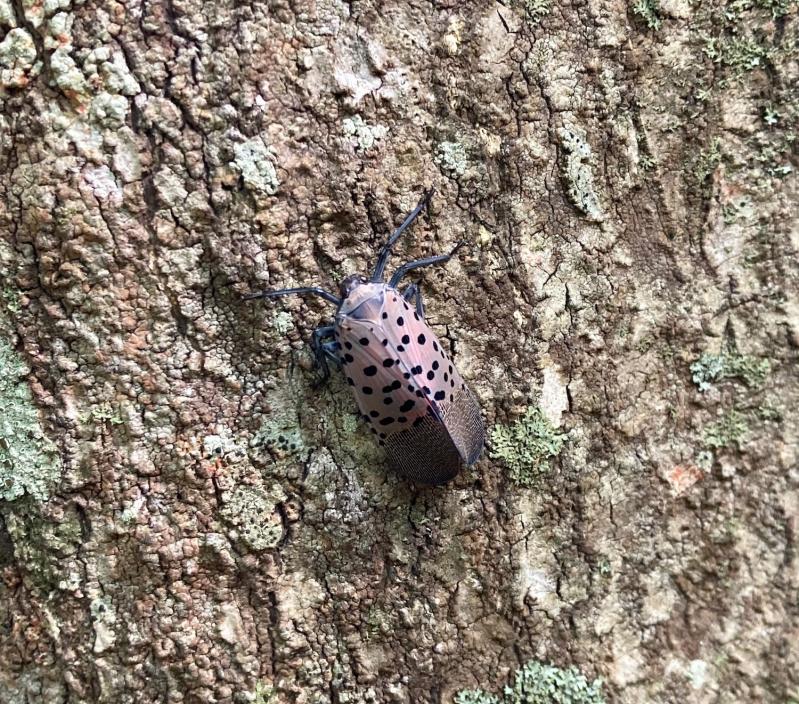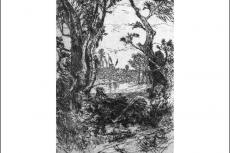The spotted lanternfly, a pest now common in New York City, has made its way to the East End. On Tuesday, Andy Gaites, the principal environmental analyst in East Hampton Town's Department of Land Acquisition and Management, found two on an ailanthus tree just south of Halsey's Marina, in a preserve at 41 Three Mile Harbor-Hog Creek Road.
Spotted lanternflies, which are "planthoppers," showed up in Pennsylvania in 2014 on a shipment of rocks originating in South Korea. They have since spread throughout the Mid-Atlantic and Northeast states, where they are a threat to wineries and native trees like the black walnut, silver maple, willow, and oak.
"As far as I know, before my find, the farthest east they were documented was Sayville," Mr. Gaites said by phone. "I expected we would see them eventually, but I thought I'd see more reports of eastward movement before they showed up here." He collected one of the lanternflies he found and killed the other.
On Friday, a few days before Mr. Gaites's discovery, Ryan Murphy, the Southampton Town emergency management administrator, wrote in a press release that if residents encounter the insects, they should terminate them with extreme prejudice. "Along with reporting the sighting, we encourage people to kill any spotted lanternflies that they see. People can step on or crush any observed spotted lanternflies to kill them," he wrote.
But it's not that easy.
"I probably tried to kill twice as many as I've actually killed," said Evan Schumann, who grew up in East Hampton but now splits his time between the South Fork and Manhattan, where he has grown familiar with the insect. "They're wily."
Nadine Whelan, an undergraduate at Stony Brook University with family on the East End, says the invasive pests are all over Pelham, N.Y., where she grew up. "You try and stomp on them, and they jump away. My dog loves them though."
Spotted lanternflies drill into victim plants and feed on sap. Then, they, well, excrete the sap as a sticky and smelly substance with the euphemistic name "honeydew."
With beech leaf disease wreaking havoc on the East End's beech trees and the southern pine beetle destroying tens of thousands of pitch pines, another invasive threat isn't what the ecology of the East End needs.
Roman Roth, a winemaker and partner at the 50-acre Wolffer Estate Vineyard in Sagaponack, had an equanimous take on the pest, placing it on equal footing with other environmental challenges faced by winemakers. "We have a team that spots for everything," he said by phone yesterday. He noted that Napa had lost an entire year due to wildfires, and other areas had lost huge percentages of grapes to frost.
"We are watching for it, but part of sustainable farming is being more tolerant. In the old days if you have a half-acre infested with mites, you'd spray the whole vineyard. Now we have more balance. A couple won't hurt us, but thousands flying around will be an issue. We'll be ready to combat them if they come out," he said.
"We have had a few confirmed reports of individuals around eastern Long Island. I am awaiting details on one other sighting, but beyond those so far there are no reports of established populations of lanternflies east of the Medford area," Dan Gilrein, an entomologist with the Cornell Cooperative Extension of Suffolk County, said in an email.
According to the New York State Department of Environmental Conservation, "In the fall, adults lay one-inch-long egg masses on nearly anything from tree trunks and rocks to vehicles and firewood. They are smooth and brownish-gray with a shiny, waxy coating when first laid." Should you find an egg mass, the D.E.C. says to destroy it by scraping the eggs into a container of hot, soapy water or rubbing alcohol.
If the egg masses make it through the winter, 30 to 50 eggs will hatch in May. The hatchlings resemble ticks. By September, they're red and have grown up to three-quarters of an inch. Then they molt, become adults, and start laying eggs. Adults can be found until December, and eggs are laid until the first freeze.
The spotted lanternfly is particularly attracted to the invasive tree of heaven, or ailanthus, which it knows from its home range in Asia. Unfortunately, this tree has spread throughout the East End.
Studies have shown that the spotted lanternflies lay seven times the number of eggs when they have access to this tree. The problem is that ailanthus trees are hard to properly remove as they multiply via their root system. Done wrong, a single tree can quickly turn into multiple saplings that shoot up from the submerged roots. In Pennsylvania, scientists have begun investigating thinning out ailanthus and using the remaining male trees (that don't drop seed) as trap trees.
Knowing their importance to the insect, Mr. Gaites had been monitoring a couple of stands of the trees in East Hampton. "I've been inspecting this site for probably three years, looking for egg masses, nymphs, and adults. This is the first time finding any. I was shocked having just told my co-worker we're going to take a quick stop we're not going to find any, but also excited to be the first one to find it. They're kind of pretty, actually."
To help monitor and control the spread of the spotted lanternfly, the public has been asked to email sightings, including photos, noting the location, to [email protected].




